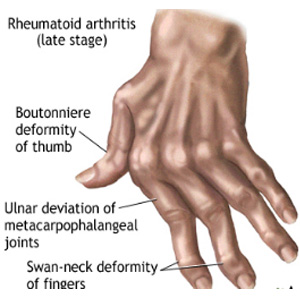Rheumatoid Arthritis
Rheumatoid arthritis (RA) is a form of inflammatory arthritis and an autoimmune disease. In RA, for reasons no one fully understands, the immune system ‚Ä� which is designed to protect our health by attacking foreign cells such as viruses and bacteria ‚Ä� instead attacks the body‚Äôs own tissues, specifically the synovium, a thin membrane that lines the joints. As a result of the attack, fluid builds up in the joints, causing pain in the joints and inflammation that‚Äôs systemic ‚Ä� meaning it can occur throughout the body. Symptoms : Pain, morning stiffness, swelling, and systemic symptoms are common. Other rheumatoid symptoms include:
- Swelling, pain, and stiffness in the joint, even when it is not being used
- A feeling of warmth around the joint
- Deformities and contractures of the joint 
- Symptoms throughout the body, such as fever, loss of appetite and decreased energy 
- Weakness due to a low red blood cell count (anemia) 
- Nodules, or lumps, particularly around the elbow 
- Foot pain, bunions, and hammer toes with long-standing disease
Investigations: Medical history A blood test may reveal an antibody called rheumatoid factor. This is an indicator of rheumatoid arthritis. X-rays can help show the progression of the disease. The American College of Rheumatology requires at least four of the following seven criteria to confirm the diagnosis:
- Morning stiffness around the joint that lasts at least 1 hour
- Arthritis of three or more joints for at least 6 weeks
- Arthritis of hand joints for at least 6 weeks 
- Arthritis on both sides of the body for at least 6 weeks 
- Rheumatoid nodules under the skin 
- Rheumatoid factor present in blood testing 
- Evidence of rheumatoid arthritis on X-rays


